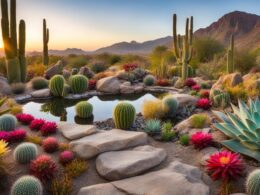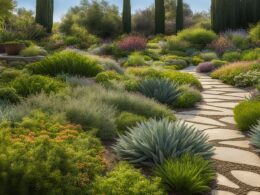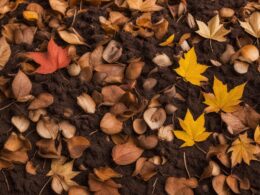Are you looking for ways to save water and create an eco-friendly garden? Consider xeriscaping, an innovative gardening strategy that focuses on long-term water savings. Xeriscaping involves designing landscapes to reduce or eliminate the need for irrigation, making it an ideal choice for regions facing water scarcity issues. By choosing drought-tolerant vegetation, implementing efficient irrigation methods, and replacing grassy lawns with native plants and rocks, xeriscaping can help you conserve water and save money in the process.
Key Takeaways:
- Xeriscaping is an eco-friendly gardening strategy that focuses on reducing water usage.
- By choosing drought-tolerant vegetation and efficient irrigation methods, you can save water and money.
- Replacing grassy lawns with native plants and rocks is key to successful xeriscaping.
- Xeriscaping promotes environmental sustainability and can increase biodiversity.
- While there may be upfront costs and visual changes, the long-term benefits make xeriscaping a worthwhile investment.
The Environmental Benefits of Xeriscaping
One of the most important environmental aspects of xeriscaping is the use of drought-tolerant plants. By replacing grassy lawns with soil, rocks, mulch, and native plant species that require little additional irrigation, xeriscaping conserves water and reduces the need for chemical fertilizers and pesticides. This approach creates a more sustainable and eco-friendly landscape. Moreover, xeriscaping with native plants can enhance biodiversity by attracting pollinators such as birds, bees, and butterflies, thereby supporting local ecosystems.
Choosing the right plants is crucial in xeriscaping. By selecting drought-tolerant species, xeriscaping can significantly decrease water consumption. These plants have adapted to arid climates and possess features that enable them to conserve water, such as waxy skin, thick stems for water storage, and reduced leaf surfaces to minimize water loss. Implementing xeriscaping with native plants that are well-suited to the specific region provides additional benefits, as they require minimal additional water and are already acclimated to the local climate.
Xeriscaping not only conserves water but also promotes sustainable landscaping practices that benefit the environment. By reducing the need for excessive water usage, chemical inputs, and lawn maintenance equipment, xeriscaping minimizes the environmental impact of traditional landscaping methods. Furthermore, the use of native and drought-tolerant plant species in xeriscaping can create habitats for wildlife, enhance local biodiversity, and contribute to the overall resilience of ecosystems.
Table: Comparison of Water Usage in Xeriscaped Landscapes vs. Traditional Lawns
| Traditional Lawns | Xeriscaped Landscapes | |
|---|---|---|
| Water Usage | High | Significantly Reduced |
| Fertilizer and Pesticide Use | Often required | Reduced or eliminated |
| Equipment and Maintenance | Regular mowing, trimming, and watering | Less frequent maintenance |
| Biodiversity | Low | Enhanced through native plant selection |
Overall, xeriscaping not only helps conserve water but also promotes sustainable landscaping practices that benefit the environment. By reducing the need for excessive water usage, chemical inputs, and lawn maintenance equipment, xeriscaping minimizes the environmental impact of traditional landscaping methods. Furthermore, the use of native and drought-tolerant plant species in xeriscaping can create habitats for wildlife, enhance local biodiversity, and contribute to the overall resilience of ecosystems.
Financial Benefits of Xeriscaping
Xeriscaping not only offers significant environmental advantages but also provides homeowners with noteworthy financial benefits. By reducing water usage and implementing sustainable landscaping practices, xeriscaping can lead to substantial savings on monthly water bills. Some studies estimate that xeriscaping can reduce water use by 50%, resulting in significant cost reductions over time.
Additionally, xeriscaping can increase property values. A well-maintained and attractive xeriscaped yard can enhance the curb appeal of a home, making it more desirable to potential buyers. Studies have shown that xeriscaped properties can experience an increase in value of up to 15%. While there may be an initial investment required for xeriscaping, the long-term financial benefits make it a cost-effective choice in the long run.
In order to illustrate the potential financial benefits of xeriscaping, the following table presents a comparison of average water bills for traditional lawns and xeriscaped landscapes:
| Traditional Lawn | Xeriscaped Landscape |
|---|---|
| $100 per month | $50 per month |
| $1,200 per year | $600 per year |
| $12,000 over 10 years | $6,000 over 10 years |
The table clearly demonstrates the potential for significant savings with xeriscaping. Over a 10-year period, homeowners could save $6,000 on water bills alone, making it a financially wise choice. Additionally, the reduced maintenance and upkeep requirements of xeriscaping can result in further cost savings.
Drought-Tolerant Plants for Xeriscaping
In xeriscaping, the selection of drought-tolerant plants is crucial for creating a water-saving and sustainable landscape. These plants, also known as xerophytes, have adapted to arid climates and require minimal additional watering. By incorporating drought-tolerant plants into your xeriscaping design, you can reduce water usage while still enjoying a beautiful garden.
Native plants are an excellent choice for xeriscaping as they are already well-suited to the local climate and typically require less water. Examples of drought-tolerant plants commonly used in xeriscaping include cacti, agave, juniper, lavender, and various herbs and spices. These plants have developed unique characteristics to conserve water, such as waxy skin, thick stems for water storage, and reduced leaf surfaces to minimize water loss.
Example of Drought-Tolerant Plants for Xeriscaping
| Plant Name | Description |
|---|---|
| Cacti | These succulents store water in their fleshy stems and have spines to reduce water loss through evaporation. They come in various shapes and sizes, adding visual interest to your xeriscaped garden. |
| Agave | Agave plants have thick leaves with sharp edges that help them collect and retain water. They come in a range of colors and sizes, making them a versatile choice for xeriscaping. |
| Juniper | Junipers are evergreen shrubs that are highly adaptable and require minimal watering. They come in different varieties, including low-growing ground covers and taller shrubs. |
| Lavender | Lavender is a fragrant flowering plant that thrives in sunny, dry conditions. It attracts pollinators like bees and butterflies, adding beauty and biodiversity to your xeriscaped garden. |
By incorporating these and other drought-tolerant plants into your xeriscaping design, you can create an aesthetically pleasing landscape that conserves water and thrives in arid climates.
Efficient Irrigation Methods for Xeriscaping
Xeriscaping not only involves choosing drought-tolerant plants but also implementing efficient irrigation methods to minimize water usage while maintaining a healthy and vibrant landscape. By using these efficient irrigation techniques, you can maximize water conservation and further reduce your environmental impact.
1. Drip Irrigation

2. Soil Grouping
Another effective technique for efficient irrigation in xeriscaping is soil grouping. By planting vegetation with similar water needs together, you can optimize water usage and minimize water loss. Grouping plants with high-water requirements in one area and low-water plants in another allows you to tailor your watering schedule to meet the specific needs of each group. This not only conserves water but also ensures that each plant receives the appropriate amount of moisture for optimal growth.
3. Time of Day and Watering Frequency
To further conserve water, it’s important to water your xeriscaped landscape at the right time of day and frequency. Watering in the early morning or late evening allows for better water absorption and reduces evaporation compared to watering in the heat of the day. Additionally, watering deeply and infrequently encourages plants to develop deep roots, making them more resilient to drought conditions. Monitoring soil moisture levels and adjusting your watering schedule accordingly is key to efficient irrigation in xeriscaping.
By utilizing efficient irrigation methods such as drip irrigation, soil grouping, and mindful watering practices, you can achieve optimal water conservation in your xeriscaped landscape. These techniques not only reduce water usage but also promote healthier plant growth and minimize the overall maintenance required. Embracing these efficient irrigation methods will help you create a sustainable and eco-friendly outdoor space that is not only visually appealing but also environmentally responsible.
Xeriscaping in Different Climates
Xeriscaping is a versatile landscaping strategy that can be adapted to different climates by selecting plants that are well-suited to the specific region. By working with the natural climate and focusing on native plant species, xeriscaping can be implemented effectively in a variety of environments. In arid regions, xeriscaping often includes the use of Mediterranean plants, which are known for their ability to thrive in hot, dry conditions and require minimal water.
The Benefits of Mediterranean Plants
Mediterranean plants, such as lavender, rosemary, and olive trees, are ideal for xeriscaping in regions with a Mediterranean climate or similar dry conditions. These plants have adapted to long, hot summers and mild, wet winters, making them resilient and drought-tolerant. Their unique characteristics, such as deep root systems, waxy leaves, and small leaf surfaces, help them conserve water and survive with minimal irrigation.
Mediterranean plants also add aesthetic appeal to xeriscaped landscapes. Their vibrant colors, fragrant aromas, and textured foliage create a visually pleasing environment that can enhance the overall appeal of your outdoor space.
Adapting Xeriscaping to Your Climate
While Mediterranean plants are well-suited for xeriscaping in dry climates, it’s important to consider your specific climate and local conditions when selecting plants for your xeriscape design. Research native plant species that are adapted to your area’s climate, soil type, and water availability. Native plants are already acclimated to the local conditions and will require minimal additional water once established.
Consulting with a local horticulturist or landscape professional can provide valuable insights into which plants will thrive in your region. They can help you choose a diverse mix of drought-tolerant plants that will not only conserve water but also attract local wildlife and support the natural ecosystem in your area.
Cost Considerations of Xeriscaping
When considering xeriscaping for your landscaping needs, it is important to weigh the upfront investment against the long-term savings. While the initial cost of implementing xeriscaping may be higher than traditional landscaping methods, the potential for significant financial benefits over time makes it a cost-effective choice.
Studies have shown that xeriscaping can lead to substantial savings in water bills. By reducing water usage by up to 50%, homeowners can enjoy a significant decrease in their monthly utility expenses. Additionally, xeriscaping requires less maintenance than traditional lawns, resulting in lower maintenance costs and potential savings on lawn care services.
Furthermore, some water agencies offer rebates and incentives for homeowners who choose to switch to xeriscaping. These programs can help offset the initial expenses and make xeriscaping a more affordable option. It is worth exploring any available rebates or incentives in your area to maximize the potential savings.
| Cost Considerations | Xeriscaping | Traditional Landscaping |
|---|---|---|
| Upfront Investment | Medium to High | Low to Medium |
| Water Bills | Reduced by up to 50% | Higher due to increased water usage |
| Maintenance Costs | Lower | Higher |
| Rebates and Incentives | Available in some areas | Not applicable |
While xeriscaping may require an upfront investment, the long-term savings in water bills, maintenance costs, and potential incentives make it a financially responsible choice. By carefully considering the cost considerations and potential savings, you can make an informed decision about whether xeriscaping is the right choice for you.
Benefits of Xeriscaping for the Environment
Xeriscaping offers numerous benefits for the environment, making it a sustainable and eco-friendly landscaping approach. One of the key advantages of xeriscaping is water conservation. By implementing drought-tolerant plants and efficient irrigation methods, xeriscaping significantly reduces water usage compared to traditional lawns and gardens. This not only helps address water scarcity issues but also mitigates the impacts of drought. With xeriscaping, you can contribute to water conservation efforts and make a positive impact on the environment.
In addition to water conservation, xeriscaping also contributes to reduced emissions. Traditional lawn maintenance often involves the use of polluting tools and machines, such as lawn mowers and leaf blowers. By minimizing the need for constant watering and maintenance, xeriscaping reduces the use of these polluting tools, resulting in reduced emissions. By choosing xeriscaping, you can help improve air quality and reduce your carbon footprint.
Furthermore, xeriscaping promotes enhanced biodiversity. By selecting native plants that are well-adapted to the local climate, xeriscaping landscapes attract various types of pollinators, including birds, bees, and butterflies. These pollinators play a crucial role in supporting local ecosystems and enhancing biodiversity. Xeriscaping with native plants not only creates a beautiful and vibrant landscape but also provides a habitat for these important pollinators, helping to preserve and protect local wildlife.
| Benefits of Xeriscaping for the Environment | |
|---|---|
| Water Conservation | Xeriscaping significantly reduces water usage compared to traditional lawns and gardens. |
| Reduced Emissions | Xeriscaping minimizes the use of polluting tools and machines, resulting in reduced emissions. |
| Enhanced Biodiversity | Xeriscaping with native plants attracts pollinators and supports local ecosystems, enhancing biodiversity. |
“Xeriscaping not only helps conserve water but also reduces emissions and enhances biodiversity, making it a sustainable and eco-friendly landscaping choice.”
By choosing xeriscaping for your landscape, you can enjoy these environmental benefits while creating a beautiful and sustainable outdoor space. Xeriscaping helps conserve water, reduces emissions, and supports local ecosystems, contributing to a greener and more sustainable future.
Challenges and Considerations of Xeriscaping
Xeriscaping offers numerous benefits, but it’s important to be aware of the challenges and considerations associated with this landscaping approach. Understanding these factors can help you make informed decisions and ensure successful implementation of xeriscaping in your own yard.
Upfront Costs
One of the main challenges of xeriscaping is the upfront investment required. While the long-term savings in water bills and maintenance costs can outweigh the initial expenses, it’s essential to budget accordingly. The cost of xeriscaping depends on factors such as the size of your yard, the specific design elements chosen, and the availability of materials. However, it’s worth noting that some water agencies offer rebates and incentives for homeowners who switch to xeriscaping, helping to offset the upfront costs.
Visual Changes
Transitioning to xeriscaping can result in visual changes to your landscape, especially during the initial stages of plant growth. As you replace grassy lawns with soil, rocks, and native plant species, it may take some time for these new elements to establish and thrive. Patience is key, as the transformation can take several months or even a year. It’s important to manage expectations and embrace the natural beauty that xeriscaped yards offer, which may differ from traditional lawns.
Homeowners Association Regulations
If you live in an area with a homeowners association (HOA), it’s crucial to familiarize yourself with any regulations or restrictions regarding landscaping. Some HOAs might have specific rules regarding the types of plants, materials, or design elements allowed. Before implementing xeriscaping, consult with your HOA and ensure that your plans align with their guidelines. Many HOAs and water agencies, however, recognize the benefits of water-saving landscaping and may have programs that support xeriscaping practices.
Despite these challenges, many homeowners find that the benefits of xeriscaping outweigh the considerations. The long-term water savings, reduced maintenance, and positive environmental impact make xeriscaping a worthwhile investment. By addressing the upfront costs, embracing visual changes, and working with any HOA regulations, you can successfully implement xeriscaping in your yard and enjoy its many advantages.
Conclusion
In conclusion, xeriscaping offers a practical and sustainable solution for homeowners looking to save water and enhance their landscapes. By embracing water-saving landscaping practices, you can significantly reduce your water usage while still enjoying a beautiful outdoor space.
The environmental benefits of xeriscaping are substantial. By conserving water, you contribute to addressing water scarcity issues and help mitigate the effects of drought. Additionally, xeriscaping promotes biodiversity by attracting various pollinators, creating a more thriving and balanced ecosystem.
From a financial perspective, xeriscaping can lead to substantial savings in the long run. With reduced water bills and lower maintenance costs, your investment in xeriscaping will pay off over time. Furthermore, some water agencies offer rebates and incentives to support and encourage the adoption of xeriscaping.
In summary, xeriscaping is a practical and environmentally friendly approach to landscaping that offers numerous benefits. By conserving water, reducing emissions, and enhancing biodiversity, you can create a sustainable and cost-effective outdoor space that will bring joy and beauty to your home for years to come.
FAQ
What is xeriscaping?
Xeriscaping is the practice of designing landscapes to reduce or eliminate the need for irrigation.
Why is xeriscaping popular in dry regions?
Xeriscaping has gained popularity in dry regions due to prolonged droughts and the need to conserve water.
What are the key components of xeriscaping?
Xeriscaping involves choosing drought-tolerant vegetation, replacing grassy lawns with soil, rocks, and native plant species, and implementing efficient irrigation methods.
How much water can xeriscaping save?
Supporters of xeriscaping claim it can reduce water use by 50-75% and save both water and money.
What are drought-tolerant plants?
Drought-tolerant plants are vegetation that requires little additional irrigation and can thrive in arid climates.
What are the financial benefits of xeriscaping?
By reducing water usage, homeowners can save money on their monthly utility bills. Xeriscaping can also increase property values by up to 15%.
What are examples of drought-tolerant plants?
Examples of drought-tolerant plants include cacti, agave, juniper, lavender, and various herbs and spices.
What are efficient irrigation methods for xeriscaping?
Drip irrigation and soaker hoses are efficient methods that minimize water evaporation. Grouping plants with similar water needs together can also optimize water usage.
Can xeriscaping be implemented in different climates?
Yes, xeriscaping can be tailored to different climates by selecting plants that are well-suited to the specific region.
What are the cost considerations of xeriscaping?
The upfront cost of xeriscaping may be higher than traditional landscaping, but the long-term savings in water bills and maintenance costs make it a cost-effective investment.
What are the environmental benefits of xeriscaping?
Xeriscaping helps address water scarcity issues, reduces emissions by minimizing the use of polluting tools, and promotes biodiversity by attracting pollinators and supporting local ecosystems.
What challenges does xeriscaping present?
Some challenges of xeriscaping include upfront costs, visual changes during plant growth, and potential restrictions from homeowners associations or local regulations.













